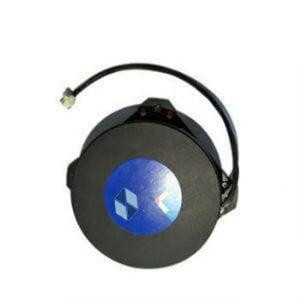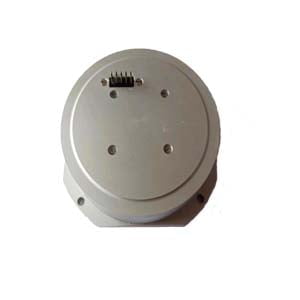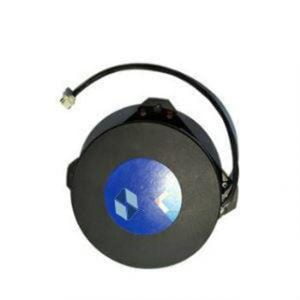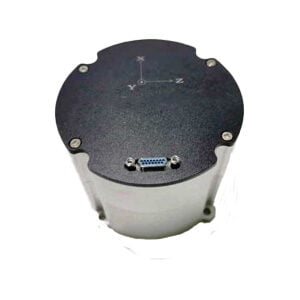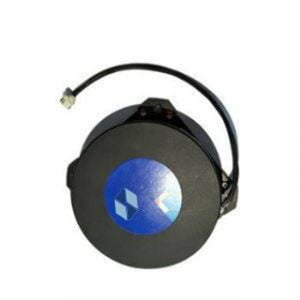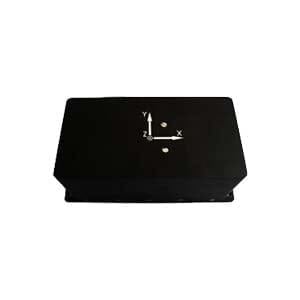1. Fiber Optical Gyroscope
The principle of fiber optic gyro is physically called Sagnac effect. In a closed optical path, two beams of light emitted from the same light source, relative propagation, confluence to the same detection point will produce interference, if the closed optical path has rotation relative to the inertial space, the beam propagating in the positive direction and the opposite direction will produce optical path difference, the difference is proportional to the upper rotation angular speed. The rotation angular velocity of the meter is calculated by measuring the phase difference of the photodetector.
Delta ∅ R = (2 PI LD/lambda c) * Ω
It can be seen from the formula that the longer the length of the fiber, the larger the light travel radius and the shorter the light wavelength. The more obvious the interference effect. Therefore, the larger the size of the fiber optic gyro, the higher the accuracy. The Sagnac effect is essentially a relativistic effect. It is very important for the design of fiber optic gyro.
The principle of a fiber optic gyroscope is that a beam of light is emitted from a photocell and passes through a coupler (1 end into 3 ends). Through the halo. Two beams enter the ring in different directions and come back around for a coherent superposition. The returned light is returned to the light-emitting diode and the intensity is detected by the light-emitting diode. The principle of fiber optic gyro looks relatively simple, but the most important thing is how to eliminate the factors that affect the optical path of the two beams. This is the most important problem facing doing fiber optic dras.
2. Principle of fiber optic gyroscope
At present, the most mature fiber optic gyro is the interferometric fiber optic gyroscope (I-FOG), that is, the first generation of fiber optic gyro, which is currently the most widely used. It uses multi-turn optical fiber coil to enhance SAGNAC effect. A double-beam ring interferometer composed of multi-turn single-mode optical fiber coil can provide high accuracy, but also will inevitably make the overall structure more complicated. Fiber optic gyros are divided into open ring fiber optic gyro and closed loop fiber optic gyro according to the type of loop. Open-loop fiber optic gyro without feedback, directly detect the optical output, save many complex optical and circuit structure, has the advantages of simple structure, cheap price, high reliability, low power consumption, the disadvantage is the input-output linearity is poor, small dynamic range, mainly used as an Angle sensor. The basic structure of an open-loop interferometric fiber optic gyro (IOFG) is a ring dual-beam interferometer. It is mainly used for occasions with low precision and small volume.
3. Fiber optic gyroscope performance indicators
Fiber optic gyro is to measure the angular speed, any measurement is error.
3.1. Noise
The noise mechanism in the fiber optic gyro is mainly concentrated in the optical or photoelectric detection part, which determines the minimum detectable sensitivity of the fiber optic gyroscope. In a fiber optic gyro, the random walk coefficient, which takes into account the detection bandwidth, is the parameter that characterizes the angular rate output white noise. In the case of white noise only, the definition of the random walk coefficient can be simplified as the ratio of the zero bias stability measured at a certain bandwidth to the square root of the detected bandwidth. If there are other types of noise or drift, the random walk coefficient should be obtained by fitting method, usually using Allan analysis of variance.
3.2 Zero drift (drift)
When using a fiber optic gyro, the Angle is used, which is obtained by integrating the angular velocity, and the cumulative error of any drift over a long time becomes larger and larger. In general, for fast response applications (short term), noise has a greater impact on the system, while for navigation applications (long term), zero drift has a greater impact on the system.
3.3 Scale factor (scale factor)
The smaller the scale factor error, the more accurate the rotation measurement will be.
4. Fiber Optic gyro future
4.1 High precision
Higher precision is an inevitable requirement for fiber optic gyro to replace laser gyro in high performance navigation. At present, the high precision fiber optic gyro technology is not fully mature.
4.2 High stability and anti-interference
Long-term high stability is also one of the development directions of fiber optic gyroscope, which can maintain navigation accuracy for a long time under harsh environment is the requirement of inertial navigation system for gyroscope. For example, in the case of high temperature, strong earthquake, strong magnetic field, etc., the fiber optic gyroscope must also have sufficient accuracy to meet the requirements of users.
4.3 Product diversification
It is necessary to develop products with different precision and different needs. Different users have different requirements for accuracy, and the structure of the fiber optic gyroscope is simple, and only the length and diameter of the coil need to be adjusted when changing the accuracy. In this respect, it has the advantage of surpassing mechanical gyroscopes and laser gyroscopes, and its different precision products are easier to achieve.
4.4 Production scale
The reduction of cost is also one of the preconditions for fiber optic gyro to be accepted by users. The production scale of various components can effectively promote the reduction of production costs, especially for middle and low precision fiber optic gyro.
5 Summary
Ericco fiber optic gyro ER-FOG-851, ER-FOG-910 high precision, good performance, no wear parts, long life, low cost, is our long-term hot products, if you are interested in our products, want to get more technical data, please feel free to contact us.
More Technical Questions
1.What is a Fiber Optic Rate Gyroscope?
2.Analysis of Fiber Optic Gyroscope Output Signal
3.Research on miniaturization technology of fiber optic gyroscope
4.What can Fiber Optic Gyroscopes be Used for?
5.Analysis of Temperature Drift Compensation Method for Fiber Optic Gyroscope
6.Who Makes Fiber Optic Gyroscopes?


